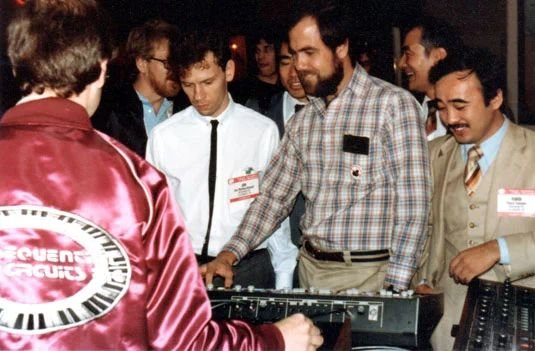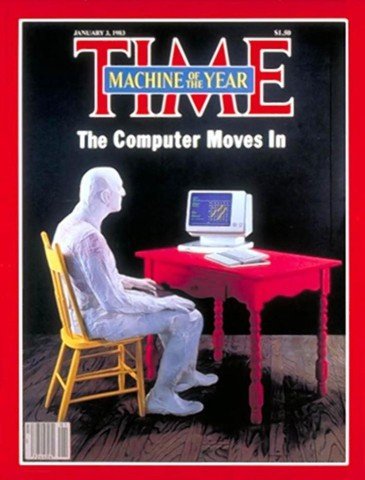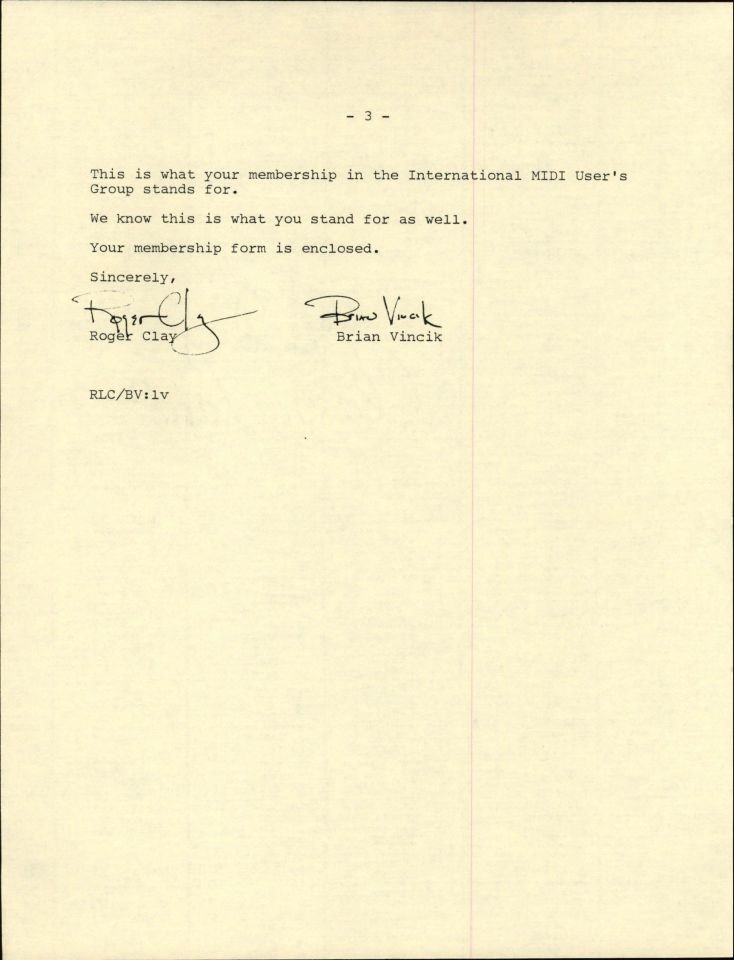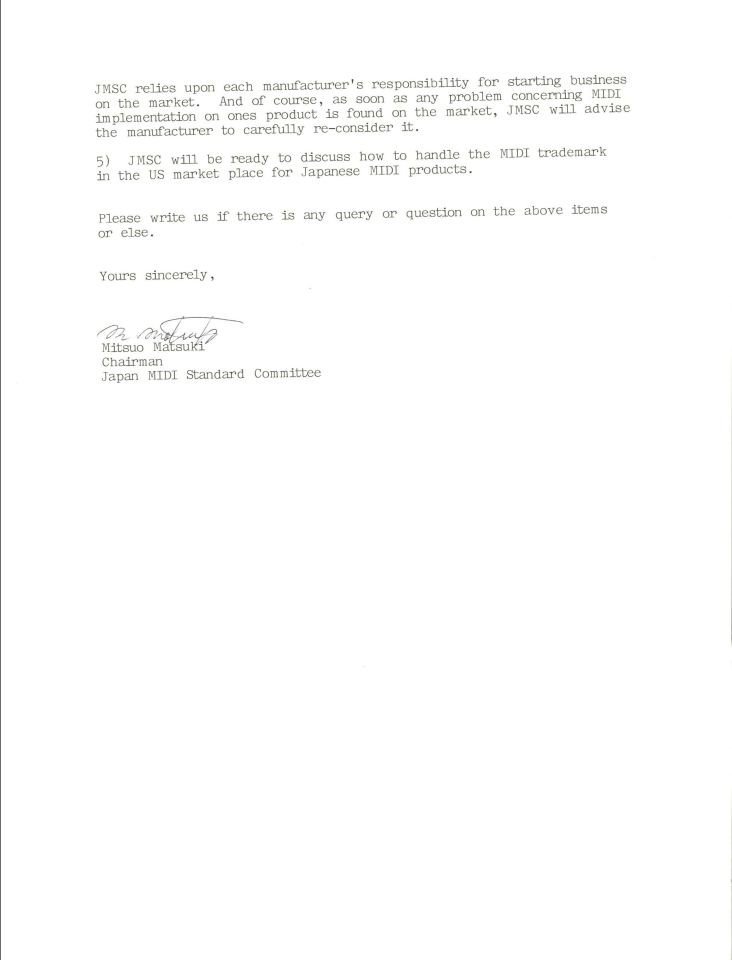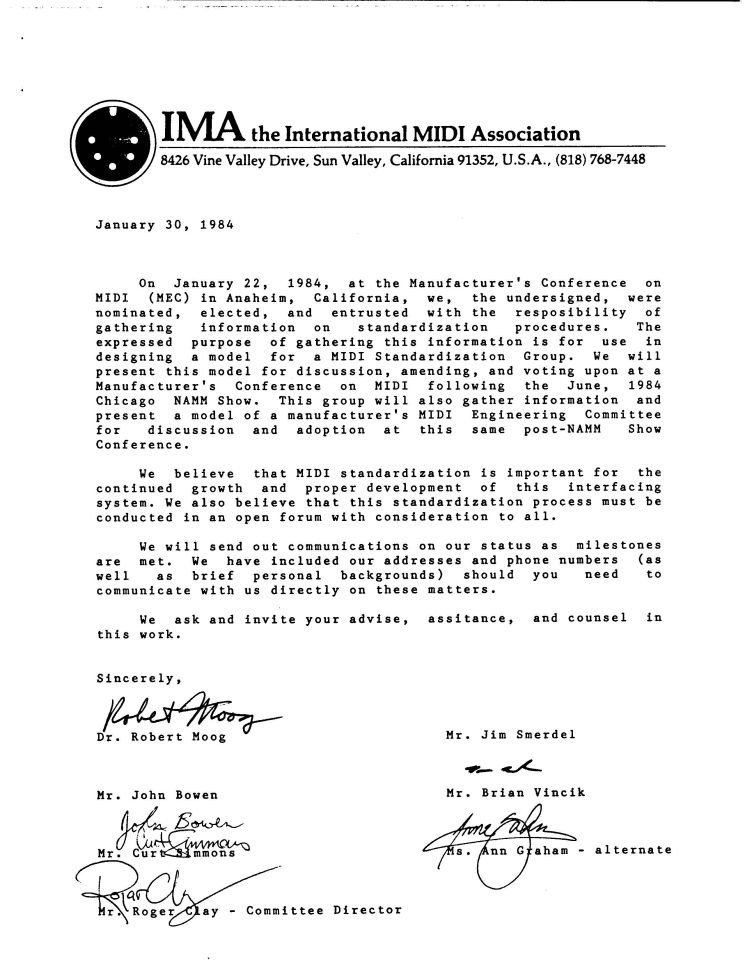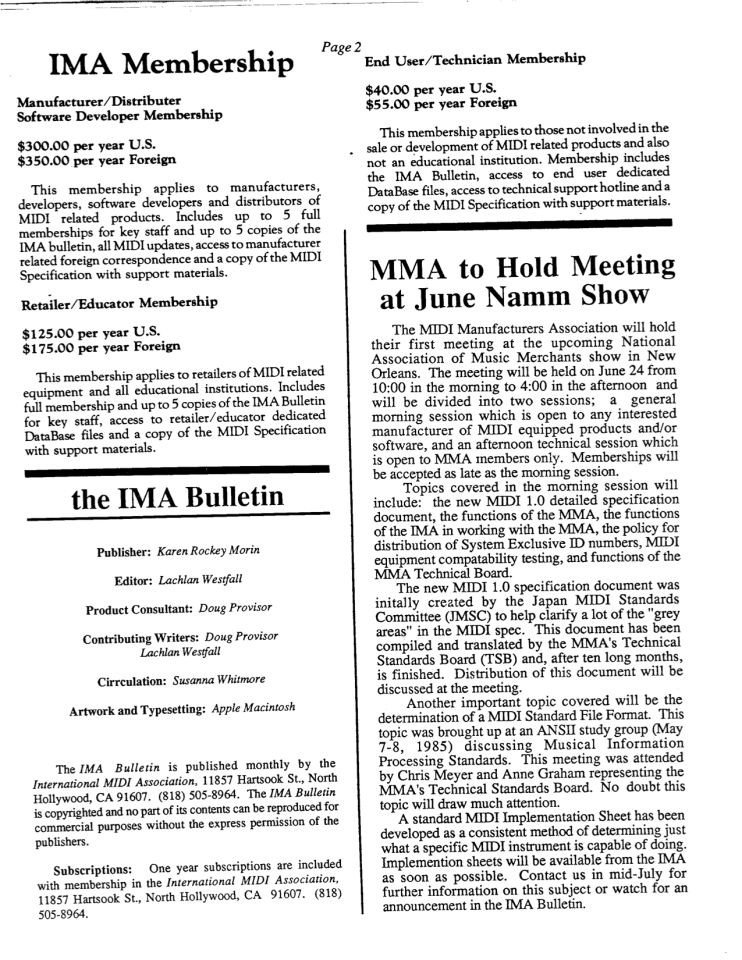MIDI History Chapter 7- MIDI Associations (1983-1985)
Check out this short history of MIDI Software, basically the software behind electronic music. Two of the pioneers of MIDI, David Smith and Brian Vincik, have been and are clients of Mark White here at White Summers.
MIDI in 1983 - It seems to work, but what's next?
In Chapter 6 of the History of MIDI, we left off with the demonstration of MIDI at the 1983 NAMM show.
John Bowen, head of sound design for Sequential had recounted that he had been busy finishing the presets for the Prophet 600 and that although Sequential had tested the Prophet 600's MIDI connecting to another Prophet 600, they really had no idea if it would work when they connected it to the Roland Jupiter 6. But it did and everybody was pretty amazed.
We also documented that at the time there were only 5 companies working on MIDI- Sequential Circuits, Kawai, Korg, Roland and Yamaha. That is pretty easy to confirm because here are the SysEx IDs in the Prophet 600 manual from December of 1982.
The People Behind MIDI
In Chapter 6 we also introduced a lot of the key players involved with MIDI.
Dave Smith and John Bowen had developed the Prophet 5 with a remote keyboard.
Oberheim and Roland and other companies had developed proprietary control protocols to connect multiple products form the same company together.
Ikutaro Kakehashi from Roland had approached Tom Oberheim at a NAMM about the idea for a Universal Synth Interface (USI) in 1981.
Dave and Chet Woods had presented an AES paper on USI in October of 1982 after talks with four Japanese companies at the 1982 Gakki Fair in Tokyo.
Bob Moog had first announced MIDI to the public in a Keyboard Magazine article in 1982 and Brian Vincik from Hewlett Packard had connected with Sequential.
Jeff Rona was working for Roland and Marcus Ryle was working for Oberheim.
One of the things that struck us when doing the research was how young many of the people who worked on MIDI were at that time.
Dave Smith and John Bowen were just 32 years old, Brian Vincik was 26, Jeff Rona was 25 and Marcus Ryle was 21.
Whose in charge of MIDI in 1983?
The four Japanese companies had been meeting regularly for over a year since the 1982 Gakki Fair.
However there was still no official organization in charge of the MIDI specification.
And the situation was even less clear in the rest of the world because it was only Sequential Circuits in the United States who had copies of the MIDI specification that existed at the time.
In the summer of 1982 when the Prophet 600 was still in development, Brian Vincik, a young engineer from Hewlett Packard (HP) took a tour of the Sequential Circuits factory and started discussions with John Bowen and Sequential about MIDI.
Brian had studied at Cal Polytechnic and his first job (similar to Dave Smith and Don Buchla) was in the aerospace industry working for Hughes Aircraft.
But his background at one of the most advanced computer companies of the time (HP) led him to immediately understand the vast potential that MIDI had.
He and John Bowen started to form ideas about what would be necessary to promote MIDI, not just to musical instrument companies, but to computer companies as well.
That suited Dave Smith because Dave was not a big fan of meetings and committees and much preferred to focus on designing new products.
Soon after the January 1983 public demonstration at NAMM, Sequential started getting phone calls and letters from individuals and companies requesting more information on this new thing called MIDI.
So Brian and John put together a plan for a MIDI Users Group (MUG).
Here is a copy of the initial goals of the MUG which were pretty expansive and included responding to all letters (yes, letters- remember this was all before not just the Internet, but the fax machine!) about MIDI, providing the MIDI specifications to anyone who wanted it , assign SysEx IDs and maintain a database with ALL user names and concerns.
MIDI User Group MIDI Committee Proposal
As a synthesizer enthusiast and engineer, Brian graduated from Cal Poly San Luis Obispo in 1979 and moved to the San Francisco Bay Area when many of the most innovative synthesizer companies were designing new musical products. Brian became friendly with many of the designers and engineers including John Bowen from Sequential Circuits and Dave Smith (who would write the MIDI Spec.) Brian formed the first MIDI user group called the International MIDI Association in 1983 and was the sole source for the MIDI specification 1.0 in those early years in MIDI's development.
by NAMM Oral History
Brian soon realized that the organization's name would need to be changed because there was already a Macintosh Users Group (MUG) so the International MIDI Association was settled on for the name and the IMA was created.
Having someone like Brian from the computer industry was significant because the same month that MIDI was introduced at the 1983 NAMM show, this was the cover of Time Magazine.
Time Magazine cover January 1983
NAMM International Music & Sound Expo
Chicago, Illinois
June 18-21 1983
Brian attended the 1983 NAMM show and was in the Sequential Circuits booth promoting MIDI and the International MIDI Association (IMA).
In fact, here is a picture at McCormick Place where the Summer NAMM was held that Brian took of a regular visitor to NAMM shows for many years, Eddie Van Halen.
The Japanese MIDI Standards Committee (JMSC) is formed
Tokyo, Japan
June 29, 1983
The Japanese MIDI Standards Committee trademarked the MIDI logo in Japan in 1983
Not surprisingly the Japanese were more organized and formalized in their approach to MIDI and associations.
The Japanese Electronic Music Industry Association (JEMIA) had been formed in 1976 and was a professional association that included manufacturers like Yamaha, Roland, Kawai and Korg.
On February of 1983 just a month after the 1983 NAMM show, the Japanese formed the MIDI Standard Liaison Committee and later the same year changed the name to the Japan MIDI Standards Committee (JMSC).
By October of 1983, JMSC had 28 corporate members and 24 individual members and was keeping them all informed about updates to the MIDI 1.0 specification.
In November of 1983, JMSC was granted a trademark on MIDI in the Japanese market.
Japan was viewing MIDI as a business strategy and not simply as a technical specification.
Compare this with the situation in the rest of the world where the IMA was struggling to keep up with the worldwide demand for information on MIDI and where the MIDI Manufacturers Association (driven strongly by Jeff Rona who worked for a Japanese company) was still 2 years away from becoming an established company.
Bob Moog Keyboard Article
MIDI- What is it, what it means to you
July, 1983
The first person to do an in depth article about MIDI was Dr. Bob Moog in his July 1983 Keyboard Magazine article.
IMA Director Roger Clay
Roger Clay and Bob Moog at the first (and last) meeting of the MIDI Evolutionary Committee at the 1984 Winter NAMM show
It's time now to introduce another person who was involved with early MIDI and particularly with the IMA.
In interviewing many people about that first tumultuous year of MIDI almost everyone would have to stop when asked about Roger Clay and say something like "Roger was a real character" or "Roger was good at promoting things (mostly himself)".
Roger got involved in the IMA because he had been working on setting up user groups for the Prophet 5 and the Rhodes Chroma and when he heard about a user group for MIDI, he saw a big opportunity to get in front of a lot of people.
Roger was involved setting up IMA in 1983 , but left the organization in November of 1984.
No one we talked to knew what happened to Roger Clay after the IMA, but if anyone knows, please contact us at info@MIDI.org.
Here is the first communication to companies and people interested in MIDI from the International MIDI USer Group that soon became the International MIDI Association.
You can see how bold (and perhaps unrealistic) the IMUG's goals were (for example setting up a testing lab to test all MIDI products before they were shipped to ensure that they were interoperable or keeping a database of every person who used MIDI).
Ikutaro Kakehashi joins the IMA
Sept. 27, 1983
Communications between IMA and JMSC
In the days after the 1983 June NAMM show, there were a number of important communications between the International MIDI Association and the Japanese MIDI Standards Committee.
In particular, Matsuki-san expressed that the Japanese felt strongly that
MIDI should remain open to the public
That both the Japanese MIDI Association and the International MIDI organization should agree together on any changes to the specification
The MIDI organization need to rely on the individual manufacturers to be responsible for their implementations.
It's interesting that 40 years later, MIDI still operates under the same fundamental principles.
The IMA- Where is this whole thing going? We're not quite sure.
As the IMA was dealing with communications with JMSC, they were also putting some some ambitious plans. But at least, the IMA was honest in their Membership brochure when they said "Where is this whole thing going? We're not quite sure".
The IMA laid out their plans for many things including a MIDI Evolutionary Council (MEC), a MIDI Database, The IMA Network, and an annual convention of "all the MIDI-related products in one place at one time.
IMA Membership Brochure Page 1
IMA Membership Brochure Page 2
The MIDI Evolutionary Committee
January 1984
Winter NAMM Show in Anaheim
Roger Clay at the Anaheim Marriott showing the actual votes for the MEC
The International MIDI Association had put formed a MIDI Evolutionary Committee that included Anne Graham from Oberheim, Bob Moog (now at Big Briar) , Curt Simmons, Jim Smerdel from Yamaha, John Bowen from Sequential Circuits as well as Brian Vincik and Roger Clay from the IMA itself.
Apple and Lucas Films join the IMA
February, 1984
MIDI Soft'84
Two Day Event in Bay Area
May 24-25, 1984
MIDISOFT'84 is a two day conference on software for one of the most exciting developments in the music field - MIDI, the Musical Instrument Digital Interface.
MIDISOFT'84, to be held at the renown Mark Hopkins Hotel in San Francisco, California, will bring together in one place for the first time, the molders and shapers of music software and will offer an open forum for the discussion of standards and practices concerning this new phenomenon.
MIDISOFT'84's main goal and purpose is to establish a MIDI Software Standards Board and to provide a introduction to Music Software and the MIDI phenomenon to the software developer and end-user alike.
Scheduled Speakers and Topics (confirmed with outlines):
Jaron Lanier (Software Author -"MOONDUST")
"MIDI/Music Software and the Consumer Market"
Alan Marr (Software Developer, LUCASFILM, LTD)
"The Uses and Development of Icons and Glyphs in Music Software"
Dr. Charles Goldfarb (Senior Analyst, IBM)
"Formats and Standardization Proposals for Musical Databases"
Robert Barkans (Documentation Consultant, DOCUPRO)by International MIDI Association
We found a pretty accurate contemporary summary of what happened at MIDIsoft'84 from the British Music Magazine "Electronics and Music Maker from their November 1984 issue.
MIDIsoft
At long last, some feedback on the two-day MIDIsoft event held back in May in a San Francisco hotel under the banner of the IMA (International MIDI Association). Given that this wasn't a free event ($35 for IMA members, $60 for non-members), the quoted attendance of 219 was pretty good. The major problem with this sort of umbrella event is that everything stands or falls on the support of the manufacturers, and unfortunately, Korg, Kurzweil, Oberheim, and E-mu were as far as the manufacturers' conclave went. And with the exception of Korg, all those names are of companies that have come late (Kurzweil and E-mu) or reluctantly (Oberheim) into the MIDI game.
Anyhow, what transpired from the various question-and-answer sessions over the two days was that (a) most of the attendees were there for serious software purposes, (b) much thought was being devoted to getting around the very obvious limitations of the MIDI standard (parallel ACIAs, use in conjunction with memory-mapped sound generators, and so on), and (c) many felt that they were being cold-shouldered by the manufacturers.
Curiously, most of the timetabled lectures were somewhat detached from the MIDI pure and simple.
For instance, Dr Gareth Loy gave a talk on software (running on a sizeable minicomputer) that has been developed at the Computer Audio Research Laboratory at the University of California in San Diego; Robert Barkan of DocuPro suggested how to write decent manuals; Dr Charles Goldfarb spoke on musical databases; and Alan Marrs from Lucas Films discussed the subject of glyphs and icons in the context of constructing film soundtracks with the infamous Audio Signal Processor.
All in all, a lot was said, a good deal was discussed, and plenty of confusion reigned about where things are going to go next.
Clearly, an unbiased arbiter of the MIDI standard is needed - and the IMA would seem to be in a good position to offer this role - but how do we go about convincing so many large and powerful manufacturers that we're not just a bunch of jokers out to extract freebies and the like from gullible publicity departments? Very difficult, I'd say. What's more, the situation is complicated by the fact that the big boys - Roland, Yamaha, Sequential Circuits - are planning their own meeting at the forthcoming NAMM convention, and of course, the IMA, haven't been invited along.by Electronics and Music Maker from their November 1984 issue.
Turmoil in MIDI land
Keyboard Magazine
June, 1984
MIDI was developed in a very short period in two different places (Japan and the United States) separated by different languages and a large ocean in a time when there was no Internet and not even fax machines. A whole lot of companies from different backgrounds in both software and hardware jumped on to MIDI very quickly in a computer industry that itself was still just getting started. It really shouldn't have surprised anyone that there were bumps in the road. Not everyone implemented arpeggiators the same way. Some sent out the notes from the keyboard and some sent out the notes from the arpeggiator. There are inconsistencies in how Pitch Bend was implemented, and famously the DX7's keyboard (one of the first MIDI instruments and one of the most successful) only went up to 100 in MIDI velocity so it sounded fine when played from its own keyboard, but could get pretty nasty when played from an external MIDI controller from another company.
All these issues and many more were pointed out in this June 1984 Keyboard Magazine article.
MIDI Manufacturers Association MeetingWinter NAMM
Anaheim, California
Feb 1-3 1985
At the next NAMM show, the major manufacturers got together and decided on a strategy to make sure that MIDI would be stable and could grow over the next decades.
At that meeting, Jeff Rona stepped up to volunteer to put together a MIDI Manufacturers Association. The new MMA and the existing IMA came to an agreement about how they would work together. This arrangement between the MMA and IMA was probably made easier by the fact that Roger Clay who had been somewhat antagonistic to the manufacturers (as seen in his comments in the Turmoil in MIDI Land article) was no longer with the IMA.
First Public Meeting of the MIDI Manufacturers Association
Summer NAMM
New Orleans, Louisiana
June 24, 1985
Jeff Rona, the first President of the MIDI Association documents the details of that meeting very well in his article "MIDI from the Inside".
He did get one small detail mixed up.
He got the place right (who could forget the heat in New Orleans that NAMM show), but the year is incorrect as the NAMM show was only held in New Orleans once and that was in 1985 (not 1983).
MIDI From The Inside -
Updated with a new Youtube video We found this excellent Youtube interview by Orchestral Tools and thought it would be a great addition to this article with the first President of the MIDI Manufacturers Association, Jeff Rona.
https://www.midi.org/articles/midi-from-the-inside
Acknowledgement of the people who made these articles possible
Before we dive into the history of the creation of MIDI, we wanted to acknowledge the key people who made this official history of the birth of MIDI possible.
These are people who were directly involved with the creation of MIDI in its early days. Some of these people have never been appropriately acknowledged for their contributions and that is one of the reasons for creating this detailed history of how MIDI came about.
Also it became clear in the two years of intense research that went into this article, that MIDI was always about connections and not just connections between products, but more importantly connections between people. There is the well known phrase "it takes village" and MIDI is a great example of how that is true. MIDI was not developed by two people or two companies, it was a group of individuals with different backgrounds and motivations who came together to do something for the greater good.
That said, we would be remiss if we did not acknowledge several key people who contributed first person resources and interviews to this article.
John Bowen- Head of sound design for Sequential Circuits, Korg R and D and now President of John Bowen Synth Design, maker of the Solaris synthesizer.
John provided insight into the interconnections between Moog and Sequential as well as multiple interviews on the early days of MIDI.
Hideki Izuchi- Roland Engineer from 1979 to his death in 2019
Izuchi-san created a report about the birth of MIDI that was presented in 2018 at the Japan National Museum of Science in Ueno Park, Tokyo. His incredibly detailed 72 page report entitled "Technical Systematic Survey on MIDI" provided much of the information for this article and confirmed many details from the Japanese side about the development of MIDI.
Jeff Rona- Composer and Founder and first President of the MIDI Manufacturers Association (MMA, now known simply as the MIDI Association)
Jeff provided the MIDI Association access to the very earliest communications of the MIDI Association in its infancy and of course as the very first President of the MIDI Manufacturers Association his contribution (along with Chris Meyer who worked at both Sequential Circuits and Roland and was the first chair of the MMA Technical Standards Board) guided MIDI through its formulative and frankly most turbulent early years.
In researching this article, we realized that the simple story that Roland and Sequential connected a Prophet 600 and a Jupiter 6 together at the 1983 NAMM show and that instantly MIDI became an overnight success was very far from the reality of what was happened between January 1983 and May of 1985 when the MIDI Manufacturers Association was formally created as a non-profit trade association.
Brian Vincek- Vice President at Hewlett-Packard and co-founder of the International MIDI Association
Brian provided access to all of the early files of the International MIDI Association (IMA). Brian and John worked closely in the very early days of MIDI and the IMA was responsible for the distribution of the initial MIDI specification to both MMA companies and individuals. His contributions to the very early days of MIDI were substantial and the files he provided for this article were invaluable.
In researching this article, we realized that the simple story that Roland and Sequential connected a Prophet 600 and a Jupiter 6 together at the 1983 NAMM show and that instantly MIDI became an overnight success was very far from the reality of what was happened between January 1983 and May of 1985 when the MIDI Manufacturers Association was formally created as a non-profit trade association.
Many other people and organizations including NAMM and AMEI provided access to their files and we thank everyone who contributed.
Thanks to those contributions, we believe that this article is the official definitive history of how MIDI got started.
Original Post:
By The MIDI Association
https://www.midi.org/midi-articles/midi-history-chapter-7-midi-associations-1983-1985

